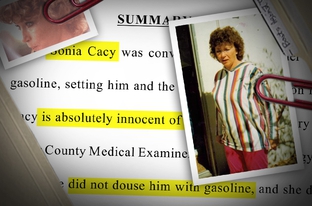A long-time-coming story of actual innocence.
A judge has ruled that Sonia Cacy, a West Texas woman convicted of setting her uncle on fire, is innocent of murder, basing his decision on new analysis of evidence presented at her 1993 trial.
“The cumulation of evidence supports Applicant’s claim of actual innocence,” visiting state District Judge Bert Richardson said in his ruling, filed Monday in Pecos County. “This court finds that Applicant makes a compelling case for actual innocence, given the overwhelming evidence.”
[…]
Cacy had served five years of a 99-year murder sentence for the 1991 death of her uncle, Bill Richardson. The two were living in his Fort Stockton home when it caught fire. Prosecutors said Cacy had set her uncle on fire, also burning the home, to get the money he left to her in his will.
But multiple experts — including the State Fire Marshal’s office — concluded that Cacy did not set her uncle ablaze. Some suspected that Richardson, a smoker, likely died of a heart attack and that the fire was accidental. Cacy was released on parole after The Texas Board of Pardons and Paroles received one of the reports, but her conviction was never lifted. The Pecos County District Attorney and the Bexar County medical examiner’s office had stood by the original investigation results.
Judge Richardson’s ruling was largely based on a 2013 state Fire Marshal’s Office report that discredited trial testimony that there was an accelerant found at the crime scene.
“The findings of the State Fire Marshal’s Office — a state organized and endorsed office — are the strongest evidence that no accelerant was present and that Bill Richardson likely died of a heart attack before being burned,” Judge Richardson wrote in a ruling that comes two years after Richardson first heard Cacy’s petition for relief in Fort Stockton.
I have to admit, this story is not one I was familiar with. The link in the quoted bit above is to a Trib story from 2010, but it goes back much farther than that. Texas Monthly adds some details to what happened this week.
Cacy’s journey through the legal system has been long, winding, and complicated. During at punishment retrial in 1996, her new attorney enlisted Dr. Gerald Hurst, the late Cambridge-educated chemist from Austin, to evaluate the forensic evidence that clinched conviction against her. Hurst discovered that the original tests, conducted by Joe Castorena of the Bexar County Forensics Lab, had been completely misread. The results didn’t find the indicators of an accelerant as he claimed. Castorena, a toxicologist by training, had in fact identified the products of pyrolysis—compounds created by burning plastic, which in many ways are similar to those of an accelerant.
Hurst was convinced these compounds came from rubberized curtains and a polyurethane foam mattress, both of which were found burned at the crime scene. Cacy’s uncle was a chain smoker who was notoriously careless with lit cigarettes, one of the most common causes of household fires. Yet in spite of the evidence, a jury affirmed Cacy’s conviction in 1996 and re-sentenced her to life in prison.
By 1998, Hurst had become obsessed with the case, and had enlisted a panel of at least a dozen respected arson experts and pathologists, all of whom concluded that the fire was accidental, and that Richardson—a man of poor health—had died of a heart attack, possibly while attempting to extinguish the flames. The Board of Pardon and Paroles was moved by the reports and promptly released Cacy that year. Now, they would go about the work of establishing her innocence.
Her attorneys filed a complaint with the Texas Forensic Science Commission in 2010, but they could not have encountered a more unsympathetic audience; the commission’s presiding officer, John Bradley, was the law-and-order Williamson County district attorney who spent years opposing DNA testing in the Michael Morton case, testing that later cleared Morton of the murder of his wife. Bradley petitioned then-state attorney general Greg Abbott for a legal opinion preventing the commission from reviewing Cacy’s case. Abbott delivered, opining that any cases prior to the formation of the commission in 2005 were out of bounds—namely Cacy’s.
Her attorneys turned to the newly reformed State Fire Marshal’s Office, whose scientific advisory panel conducted a lengthy examination of the case and concluded that there was no evidence of arson. Cacy took the report to the Texas Court of Criminal Appeals in 2012, along with some shocking new evidence: Castorena, the toxicologist, admitted in a letter to her counsel, Dallas lawyer Gary Udashen, that the clothing samples he’d tested had been contaminated in either the morgue or the lab. Thus, his baffling reasoning went, anyone who didn’t know about the contamination couldn’t accurately interpret the results. Asked why he never reported this, Castorena replied, “nobody asked me.”
It gets more ridiculous from there. Texas Monthly has three other stories about the history of the case, which as the second one notes was one of the driving forces in reforming how fire investigations are done in Texas and why old arson cases are being reviewed to see which ones relied on bogus, outdated investigative techniques. It’s a little jolting to see John Bradley’s name pop up in this discussion, but hardly surprising. And please, can we scrub the descriptor “law-and-order” from stories involving Bradley? We know full well by now that he was the opposite of “law-and-order” – he was an unscrupulous liar who worked tirelessly to keep innocent people in jail. The adjectives he deserves are all some variation on “disgraced”. Anyway, click on all the links and learn more about Sonia Cacy and how terribly wronged she was by the justice system. The fact that this wrong is finally being made right doesn’t change any of what happened in the past.

